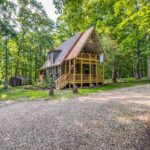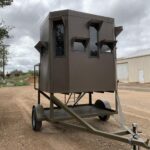As a landscape design expert, I understand that not everyone has the luxury of owning acres upon acres of land. In fact, many homeowners are faced with limited outdoor space when it comes to their backyard. However, just because you have a small yard doesn’t mean you can’t transform it into an inviting and functional oasis.
With some creativity and strategic planning, small backyard landscaping ideas can turn your modest outdoor area into a beautiful retreat. Whether you’re looking to create a cozy seating area for entertaining guests or simply want to add some greenery to brighten up your space, there are plenty of options available. From vertical gardens to strategically placed lighting fixtures, in this article we will explore various ways to maximize your small backyard’s potential and make it feel like a luxurious escape from the hustle and bustle of everyday life.
Assessing Your Space And Needs
Assessing Your Space and Needs:
Before embarking on any landscaping project, it is crucial to assess your space and determine your needs. The first step in this process is measuring the area you have available for your backyard design. This will help you determine what features can fit into your space and how much of each element you can incorporate.
Once you have measured your space, it’s time to determine your budget. How much money are you willing to spend? Do you want a complete overhaul or just some minor changes? Knowing the answers to these questions will help guide your decisions when selecting materials and plants for your backyard design.
Remember that assessing your space and determining your needs are not tasks to be taken lightly. With careful planning, you can create a beautiful outdoor oasis that meets both your practical and aesthetic requirements without breaking the bank.
Creating A Focal Point
Assessing your space and needs is crucial in designing a small backyard. Once you have identified the purpose of your outdoor area, it’s time to create a focal point that will enhance its overall aesthetic appeal. A well-designed focal point can help draw attention away from any flaws or limitations of your space while creating an inviting ambiance.
Water features are excellent options for creating a relaxing atmosphere in your backyard. From fountains to ponds, water elements add movement and sound, making them perfect for unwinding after a long day. Sculptural elements like statues or sculptures also make great focal points as they add character and personality to your garden design.
When choosing materials for your focal point, consider color schemes and textural contrasts. Play up the colors found in nature by incorporating plants with bright foliage colors such as reds, oranges, yellows, pinks or purples. Use different textures to define spaces and boundaries within the garden; mix rough stones with smooth pebbles or use grasses alongside soft ground covers.
- Install a water feature such as a fountain or mini pond.
- Add sculptural pieces like garden art or decorative statues.
- Incorporate colorful flowers and textured greenery into the landscape design.
Your choice of focal point should reflect both your personal style and practical needs while complementing other landscaping elements in the yard. With careful planning, selecting suitable hardscaping materials coupled with creative planting solutions for this intimate outdoor space could produce fantastic results!
Incorporating Vertical Gardens
Vertical gardens are a great way to add some greenery and style to your small backyard. They can be easily created with simple DIY projects, making them accessible and affordable for anyone. The benefits of vertical gardening go beyond just the aesthetic appeal they provide.
Firstly, vertical gardens are space savers – perfect for small backyards where every inch counts. By growing plants vertically, you can make use of walls or fences that might otherwise go unused. This creates more floor space for outdoor activities such as dining or lounging. Secondly, vertical gardens help purify the air by reducing pollution levels and increasing oxygen production. This is especially important in urban areas with high levels of pollution.
Moreover, maintaining a vertical garden is relatively easy compared to traditional horizontal ones. It’s easier to water, prune, and harvest crops when they’re at eye level rather than bending down on all fours. Plus, it reduces the risk of pests infesting your garden since many insects prefer crawling along the ground instead of climbing up walls.
Incorporating a DIY vertical garden into your small backyard landscaping plan can bring numerous benefits while adding beauty and personality to your outdoor space. With careful planning and execution, this project can transform an ordinary wall or fence into a vibrant living work of art that you’ll enjoy year after year!
Adding Lighting Fixtures
Lighting is a crucial aspect of backyard landscaping. Not only does it add ambiance and beauty to the outdoor space, but it also provides safety and security when traversing through the area at night. When considering adding lighting fixtures to your small backyard, you have two options: DIY or professional installation.
DIY projects are often more cost-effective than hiring a professional to install your lighting fixtures. However, if you lack experience in electrical work, this option may not be the safest choice for you. Additionally, while DIY projects can save money initially, they could end up costing more in the long run if mistakes are made during installation that require costly repairs.
When deciding between cost and aesthetics, it’s important to strike a balance between both factors. While budget-friendly options exist for lighting fixtures, sometimes these choices do not provide adequate illumination or fail to complement the overall design of your backyard landscape. In contrast, high-end fixtures may look stunning but come with an expensive price tag. It’s best to consider all factors before making a decision on which type of fixture to purchase.
Remember that proper placement of lighting fixtures is critical in achieving optimal results for your small backyard landscaping project. Whether you choose to take on the task yourself or hire professionals, make sure that each fixture is strategically placed according to its intended purpose – whether it be illuminating walkways or highlighting specific features within the yard. By doing so, you’ll ensure that your small backyard will become an inviting oasis even after sunset.
Utilizing Multi-Functional Furniture
Now that we’ve discussed the importance of adding lighting fixtures to your small backyard, let’s move on to another essential aspect of landscaping: utilizing multi-functional furniture. With limited space, it’s important to make every piece count by choosing items that serve more than one purpose.
One great example of this is convertible seating. These pieces can be used as traditional outdoor chairs or benches, but also have the ability to transform into loungers or even tables. This versatility not only saves space but also adds an interesting design element to your backyard.
Another way to maximize space and function in a small backyard is by incorporating dual-purpose planters. These unique containers not only allow you to grow plants, flowers, and herbs but can also double as storage for gardening tools or other outdoor equipment. This clever solution ensures that everything has its place without cluttering up your already-limited outdoor space.
By carefully selecting multi-functional furniture like convertible seating and dual-purpose planters, you’re able to add both style and practicality to your small backyard landscaping design. Don’t be afraid to get creative with these elements – they can truly enhance the overall look and feel of your outdoor living area.
Maximizing Storage Space
I’m a big fan of utilizing vertical space when it comes to maximizing storage space in a small backyard. By adding shelves and/or racks along fences or walls, you can get a lot of storage without taking up much room. You can also maximize existing structures, such as an outbuilding or garage, by making sure they are organized and adding extra cabinets or shelves. If you’re looking for something more creative, you could add an arbor or trellis to your backyard and use it to hang pots and other items. With a little creativity, there are plenty of ways to maximize storage space in a small backyard.
Utilizing Vertical Space
Are you feeling cramped in your small backyard? Don’t worry, there’s a solution to maximize your storage space without sacrificing any precious square footage. Utilizing vertical space is the key! With hanging planters and trellis walls, you can add gorgeous greenery while keeping your ground free for furniture or play.
For an added bonus of fresh herbs and stunning aesthetics, consider installing a vertical herb garden with climbing vines. This will not only provide easy access to cooking essentials but also create a natural privacy screen for your outdoor retreat. Plus, it adds texture and dimension that makes even the smallest spaces feel larger.
With these ideas in mind, don’t let limited yard size hold you back from enjoying nature at its finest. Get creative, think up high and transform your small backyard into a lush oasis that maximizes both beauty and functionality.
Maximizing Existing Structures
Now that we’ve covered how to utilize vertical space in a small backyard, let’s talk about maximizing existing structures. Repurposing furniture and getting creative with planters can make a huge impact on your storage capabilities without sacrificing style.
Firstly, consider using old dressers or bookshelves as outdoor storage units. With the right weather-resistant paint or sealant, these pieces can be transformed into stylish and functional additions to your backyard. You could also add hooks or shelves onto fences or walls for additional hanging storage options.
Secondly, when it comes to creative planters, think beyond traditional pots. Use items such as old tires, pallets, or even rain gutters to create unique planting spaces. This not only adds visual interest but also saves valuable floor space while still allowing you to enjoy the beauty of nature.
By incorporating repurposed furniture and out-of-the-box planter ideas, you can maximize every inch of your small backyard. Don’t be afraid to get creative and try new things—you may just surprise yourself with what you’re able to achieve!
Creative Storage Solutions
Now that we’ve explored how to maximize existing structures in a small backyard, let’s delve into the world of creative storage solutions. With some DIY projects and repurposing items, you can create functional yet stylish storage spaces that are perfect for your outdoor needs.
One great way to utilize unused space is by creating hanging storage options. By adding hooks or shelves onto fences or walls, you can free up valuable floor space while still having plenty of room to store everything from gardening tools to outdoor decor. Additionally, consider using old dressers or bookshelves as outdoor storage units with weather-resistant paint or sealant.
Another fun idea when it comes to maximizing storage space is by getting creative with planters. Instead of traditional pots, use items such as old tires, pallets, or even rain gutters to create unique planting spaces that add visual interest while also saving precious square footage. These repurposed planters not only look great but also provide an opportunity for greenery even in tight areas.
By incorporating these creative storage solutions into your backyard design plans, you’ll be able to make the most out of every inch of space available. So why settle for cluttered chaos when you can have a beautiful and organized outdoor oasis?
Selecting The Right Plants For Your Space
Choosing the right plants for your small backyard can make a huge difference in its appearance and functionality. There are countless plant species that you could choose from, but not all will thrive in your space. This is why it’s important to consider factors like soil type, sun exposure, and watering needs before making any decisions.
When selecting plants for your small backyard landscaping project, you should start by evaluating the type of soil you have. Some plants require well-drained soils while others prefer moist ones. Additionally, some plants may be able to tolerate acidic or alkaline soils better than others. Understanding these nuances will help ensure that you select the right plant species for your specific situation.
Sun exposure and watering needs are also critical considerations when choosing the right plants for your small backyard. For example, if you’re planting in an area with full sunlight, then drought-tolerant plants might be more suitable since they’ll need less water to survive. On the other hand, if your yard has spots that receive partial shade, then you’ll want to look into shade-loving plants with higher water requirements. By taking these factors into account during the planning stage of your landscape design process, you’ll increase your chances of success and create a beautiful outdoor sanctuary that brings joy year-round.
Remember: finding the best mix of plant species takes time and patience; there’s no one-size-fits-all solution when it comes to landscaping! But by following these guidelines on soil type, sun exposure, and watering needs throughout this selection process –and perhaps consulting with a professional–you can create a stunning oasis tailored specifically to meet both aesthetic goals as well as practical considerations such as maintenance level or environmental impact over time without sacrificing beauty nor functionally at any point along the way!
Frequently Asked Questions
How Much Does A Small Backyard Landscaping Project Typically Cost?
When it comes to planning a landscaping project, one of the first questions on everyone’s mind is how much it will cost. The answer depends on various factors such as the scope of work, materials used, and labor costs. If you’re looking to save money, you can opt for a DIY approach, but keep in mind that this requires time, effort, and skill. On the other hand, hiring a professional ensures quality workmanship but also comes with a higher price tag. Budget planning is crucial regardless of which route you take. Be realistic about what you can afford and prioritize your wants versus needs. Remember that even small changes can make a big impact in transforming your backyard into an outdoor oasis.
Are There Any Regulations Or Permits Required For Backyard Landscaping Projects?
Before undertaking any backyard landscaping project, it’s important to understand the legal restrictions and permits required by your local government. Depending on the scope of your project, you may need to obtain a zoning permit or a building permit from your city or county office. In some cases, there may be additional regulations regarding drainage, irrigation, and plant selection that you’ll need to follow. As a landscape design expert, I always recommend consulting with a professional in this field who can assist you in navigating these requirements and ensuring that your project is compliant with all necessary regulations.
What Are Some Common Mistakes To Avoid When Designing A Small Backyard Landscape?
When it comes to designing a backyard landscape, there are several common mistakes that homeowners often make. One of the most significant errors is failing to consider the overall design and layout of their yard before implementing any changes. Another mistake is choosing plants or features that are not appropriate for their local climate or soil conditions. To avoid these issues, it’s crucial to work with an experienced landscape designer who can provide valuable design tips and recommendations based on your specific needs and goals. By taking the time to plan ahead and select the right elements for your space, you can create a beautiful outdoor oasis that meets all of your functional and aesthetic needs.
How Can I Incorporate A Water Feature Into My Small Backyard?
When incorporating a water feature into your backyard, one must first decide between a waterfall or fountain. A fountain can be a great option for small spaces as it doesn’t take up too much room and provides soothing sounds that enhance the ambiance of any outdoor space. However, if you have more space to work with, consider installing a waterfall which adds an eye-catching element to your landscape design. To make the water feature blend in seamlessly with your garden, incorporate rocks or plants around it. By doing so, you’ll create a natural-looking oasis that will provide relaxation and tranquility in your own backyard.
What Are Some Unique And Creative Ways To Add Color To A Small Backyard?
To add color to a backyard, there are numerous unique and creative ways that can be incorporated. Vertical gardens are an excellent option for those with limited space as they allow plants to grow upwards instead of outwards. Additionally, colorful furniture pieces such as chairs or tables can instantly brighten up any outdoor living area. Mosaic stepping stones provide both functionality and aesthetic appeal while painted planters can showcase beautiful blooms in vibrant hues. These options, along with many others, offer endless possibilities for adding color to your backyard oasis.
Conclusion
In conclusion, designing a small backyard landscape can be challenging but also rewarding. As a landscape design expert, I recommend considering the cost and necessary regulations before starting any project. It is important to avoid common mistakes such as overcrowding with too many plants or not leaving enough open space for seating and entertaining.
Adding a water feature can create a calming ambiance and serve as a focal point in your small backyard. There are many options available such as fountains, ponds, and even miniature waterfalls that can fit into smaller spaces. Finally, don’t be afraid to get creative with adding color through unique plant choices, colorful accents like outdoor rugs and pillows, or incorporating art pieces into your design. With these tips in mind, you can transform your small backyard into an inviting oasis perfect for relaxation or entertaining guests.







